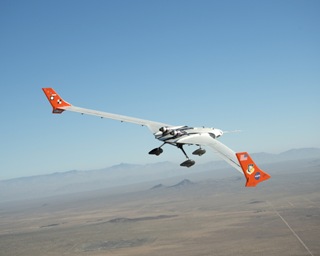Sep 3 2015
Marking a milestone for the X-56A Multi-Utility Technology Testbed (MUTT), researchers at NASA’s Armstrong Flight Research Center, Edwards, California, completed a series of performance envelope expansion flights on August 11.
 NASA researchers are using the remotely piloted X-56A to explore the behavior of lightweight, flexible aircraft structures. Credits: NASA Photo / Jim Ross
NASA researchers are using the remotely piloted X-56A to explore the behavior of lightweight, flexible aircraft structures. Credits: NASA Photo / Jim Ross
These sorties, the first of which took place April 9, represent the first flights of the second of two X-56A air vehicles built by Lockheed Martin under a contract from the U.S. Air Force Research Laboratory (AFRL). These flights were the first tests of the NASA-developed control laws, and the first flights demonstrating control of the aircraft with a negative static margin or unstable center-of-gravity configuration.
According to project engineer Chris J. Miller, “We have completed the stiff wing envelope expansion phase, which included exploring the static margin envelope.”
NASA expanded the vehicle’s negative stability envelope up to 130 knots, matching the velocity previously cleared by Lockheed Martin on the first X-56A vehicle.
Thus far, the modular X-56A has been flown with a conventional stiff wing but will later be fitted with an advanced, lightweight flexible airfoil. Initial NASA flights provided researchers an opportunity to check out aircraft systems, evaluate handling qualities, characterize and expand the airplane’s performance envelope, and verify preflight predictions regarding aircraft behavior. Although the aircraft sustained minor damage due to a landing incident on its final stiff-wing flight, it should not delay the project. The X-56A is scheduled to spend approximately six months undergoing maintenance and modification in preparation for the first flex-wing flights, currently scheduled for early 2016.
“We achieved all of our primary stiff wing objectives,” Miller said.
The MUTT effort includes participants from several NASA centers. While flight-testing is taking place at Armstrong engineers at Langley Research Center, Hampton, Virginia, and Glenn Research Center, Cleveland, Ohio, are involved with modeling and analysis.
Researchers expect data gathered with the remotely piloted MUTT will yield significant advances in aeroservoelastic control technology, which involves the interaction of an airplane’s automatic flight controls with the response of non-rigid structures to aerodynamic forces. The X-56A aircraft are being flown in support of the AFRL’s and NASA’s Advanced Air Transport Technology (AATT) project’s Higher Aspect Ratio Wing subproject, Performance Adaptive Aeroelastic Wing element.